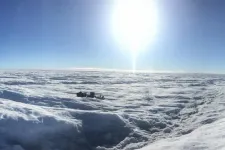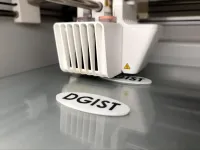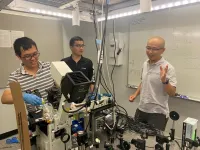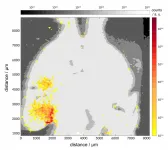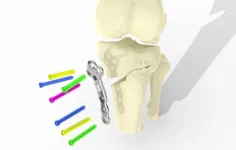(Press-News.org) The sun provides a daunting source of electromagnetic disarray - chaotic, random energy emitted by the massive ball of gas arrives to Earth in a wide spectrum of radio frequencies. But in that randomness, Stanford researchers have discovered the makings of a powerful tool for monitoring ice and polar changes on Earth and across the solar system.
In a new study, a team of glaciologists and electrical engineers show how radio signals naturally emitted by the sun can be turned into a passive radar system for measuring the depth of ice sheets and successfully tested it on a glacier in Greenland. The technique, detailed in the journal Geophysical Research Letters on July 14, could lead to a cheaper, lower power and more pervasive alternative to current methods of collecting data, according to the researchers. The advance may offer large-scale, prolonged insight into melting ice sheets and glaciers, which are among the dominant causes of sea-level rise threatening coastal communities around the world.
A sky full of signals
Airborne ice-penetrating radar - the primary current means for collecting widespread information about the polar subsurface - involves flying airplanes containing a high-powered system that transmits its own "active" radar signal down through the ice sheet. The undertaking is resource-intensive, however, and only provides information about conditions at the time of the flight.
By contrast, the researchers' proof of concept uses a battery-powered receiver with an antenna placed on the ice to detect the sun's radio waves as they travel down to Earth, through the ice sheet and to the subsurface. In other words, instead of transmitting its own signal, the system uses naturally occurring radio waves that are already traveling down from the sun, a nuclear-powered transmitter in the sky. If this type of system were fully miniaturized and deployed in extensive sensor networks, it would offer an unprecedented look at the subsurface evolution of Earth's quickly changing polar conditions, the researchers say.
"Our goal is to chart a course for the development of low-resource sensor networks that can monitor subsurface conditions on a really wide scale," said lead study author Sean Peters, who conducted research for the study as a graduate student at Stanford and now works at the MIT Lincoln Laboratory. "That could be challenging with active sensors, but this passive technique gives us the opportunity to really take advantage of low-resource implementations."
A random advantage
In addition to visible and other kinds of light, the sun is constantly emitting radio waves across a wide, random spectrum of frequencies. The researchers used this chaos to their advantage: They recorded a snippet of the sun's radioactivity, which is like an endless song that never repeats, then listened for that unique signature in the echo that's created when the solar radio waves bounce off the bottom of an ice sheet. Measuring the delay between the original recording and the echo allows them to calculate the distance between the surface receiver and the floor of the ice sheet, and thus its thickness.
In their test on Store Glacier in West Greenland, the researchers computed an echo delay time of about 11 microseconds, which maps to an ice thickness of about 3,000 feet - a figure that matches measurements of the same site recorded from both ground-based and airborne radar.
"It's one thing to do a bunch of math and physics and convince yourself something should be possible - it's really something else to see an actual echo from the bottom of an ice sheet using the sun," said senior author Dustin Schroeder, an assistant professor of geophysics at Stanford's School of Earth, Energy & Environmental Sciences (Stanford Earth).
From Jupiter to the sun
The idea of using passive radio waves to collect geophysical measurements of ice thickness was initially proposed by study co-author Andrew Romero-Wolf, a researcher with NASA's Jet Propulsion Laboratory, as a way of investigating Jupiter's icy moons. As Schroeder and Romero-Wolf worked together with others on a mission, it became clear that radio waves generated by Jupiter itself would interfere with their active ice-penetrating radar systems. At one point, Romero-Wolf realized that instead of a weakness, Jupiter's erratic radio emissions might actually be a strength, if they could be turned into a source for probing the subsurface of the moons.
"We started discussing it in the context of Jupiter's moon Europa, but then we realized it should work for observing Earth's ice sheets too if we replace Jupiter with the sun," Schroeder said.
From there, the research team undertook the task of isolating the sun's ambient radio emissions to see if it could be used to measure ice thickness. The method involved bringing a subset of the sun's 200- to 400-megahertz radio frequency band above the noise of other celestial bodies, processing massive amounts of data and eliminating man-made sources of electromagnetism like TV stations, FM radio and electronic equipment.
While the system only works when the sun is above the horizon, the proof-of-concept opens the possibility of adapting to other naturally occurring and man-made radio sources in the future. The co-authors are also still pursuing their original idea of applying this technique to space missions by harnessing the ambient energy emitted by other astronomical sources like the gas giant Jupiter.
"Pushing the frontiers of sensing technology for planetary research has enabled us to push the frontiers of sensing technology for climate change," Schroeder said. "Monitoring ice sheets under climate change and exploring icy moons at the outer planets are both extremely low-resource environments where you really need to design elegant sensors that don't require a lot of power."
INFORMATION:
Schroeder is also an assistant professor, by courtesy, of electrical engineering and a center fellow, by courtesy, at the Stanford Woods Institute for the Environment. Study co-authors include Winnie Chu of the Georgia Institute of Technology; Davide Castelletti of the Department of Geophysics, now with Capella Space; Mark Haynes of the NASA Jet Propulsion Laboratory; and Poul Christoffersen of the Scott Polar Research Institute and Department of Geography at the University of Cambridge.
This research was partially funded by NASA Cryospheric Sciences.
The treatment of many medical issues like abnormal gait and muscular disorders require an accurate sensing of applied pressure. In this regard, flexible pressure sensors that are simple, lightweight, and low-cost, have garnered considerable attention. These sensors are designed and manufactured through "additive manufacturing," or what is more commonly called "3D printing," using conductive polymer composites as their building blocks.
However, all 3D-printed pressure sensors developed so far are limited to sensing applied forces along a single direction only. This is hardly enough for real ...
CHAMPAIGN, Ill. -- Sharing ideas in an online learning environment has a distinct advantage over sharing personal details in driving learner engagement in massive open online courses, more commonly known as MOOCs, says new research co-written by a University of Illinois Urbana-Champaign expert who studies the intersection of marketing and digital environments.
Online learning engagement can be increased by nearly one-third by simply prompting students to share course ideas in a discussion forum rather than having them share information about their identity or personal motivations for enrolling, said Unnati Narang, a professor of business administration at the Gies College ...
RESEARCH TRIANGLE PARK, N.C. -- Army-funded research identified a new chemistry approach that could remove micropollutants from the environment.
Micropollutants are biological or chemical contaminants that make their way into ground and surface waters in trace quantities.
Using a pioneering imaging technique, Cornell University researchers obtained a high-resolution snapshot of how ligands, molecules that bind to other molecules or metals, interact with the surface of nanoparticles. In doing so, they made an unexpected breakthrough discovery. They determined that by varying the concentration of an individual ligand they could control the shape of the particle it attached too.
This approach could ...
When there is a gas leak in a large building or at an industrial site, human firefighters currently need to go in with gas sensing instruments. Finding the gas leak may take considerable time, while they are risking their lives. Researchers from TU Delft (the Netherlands), University of Barcelona, and Harvard University have now developed the first swarm of tiny - and hence very safe - drones that can autonomously detect and localize gas sources in cluttered indoor environments.
The main challenge the researchers needed to solve was to design the Artificial Intelligence for this complex task that would fit in the tight computational and memory constraints of the tiny drones. They solved this challenge by means of bio-inspired navigation and search strategies. The scientific ...
A new study finds forensics researchers use terms related to ancestry and race in inconsistent ways, and calls for the discipline to adopt a new approach to better account for both the fluidity of populations and how historical events have shaped our skeletal characteristics.
"Forensic anthropology is a science, and we need to use terms consistently," says Ann Ross, corresponding author of the study and a professor of biological sciences at North Carolina State University. "Our study both highlights our discipline's challenges in discussing issues ...
Super-thin carbon molecular sieve (CMS) membranes may not be best for separating industrially important chemical mixtures. However, ensuring the CMS film thickness is just right could enable more energy-efficient purification of chemical products, KAUST researchers have shown.
CMS membranes, as their name suggests, can purify mixtures of liquids or gases by permitting only certain molecules to pass through their subnanometer-sized pores. Currently, the chemical industry mainly uses heat-based processes such as distillation to separate product mixtures, but these processes consume about 10 percent of global energy output. "This situation is highly unsustainable," says Wojciech Ogieglo, a research scientist at KAUST. "We believe that a good ...
The premise of heated tobacco (HT) is simple: tobacco leaf is heated, never burnt, so avoiding many harmful by-products of combustion for the user. The exhaled 'mist' is correctly termed an aerosol, which is almost invisible and far less dense and pungent than the exhaled smoke from combustible cigarettes.
Another advantage of HT is that there are no 'side-stream' emissions to impact air quality (or disturb bystanders - these emissions form part of the ambient smoke that's often known as environmental tobacco smoke (ETS) or 'second-hand' smoke), because unlike a combustible cigarette there is no constantly burning tip. Our previous research suggests that, unlike cigarettes, using our Pulze heated tobacco device causes no negative impact on indoor air quality ...
Researchers have found evidence for an anomalous phase of matter that was predicted to exist in the 1960s. Harnessing its properties could pave the way to new technologies able to share information without energy losses. These results are reported in the journal Science Advances.
While investigating a quantum material, the researchers from the University of Cambridge who led the study observed the presence of unexpectedly fast waves of energy rippling through the material when they exposed it to short and intense laser pulses. They were able to make these observations by using a microscopic speed camera that can track small and very fast movement on a scale that is challenging with many other techniques. This technique probes the material with two light pulses: the first one disturbs it ...
In lab tests, Imperial researchers have created a metal-based molecule that inhibits the build-up of a peptide associated with Alzheimer's disease.
A peptide is a fragment of a protein, and one of the key hallmarks of Alzheimer's disease is the build-up of a specific peptide known as amyloid-β. The team demonstrated that with the aid of ultrasound, their molecule can cross the blood-brain barrier in mice, targeting the part of the brain where the damaging peptide most often accumulates.
Alzheimer's disease is the most common form of dementia, affecting approximately 50 million people worldwide. There is a pressing need to develop drugs ...
Pioneering 'printed metal' procedure to create bespoke treatment for early knee osteoarthritis set to be trialled in the UK following MHRA approval.
World's first 3D printed high tibial osteotomy (HTO) device and procedure developed at University of Bath given approval for UK trials
Bespoke titanium alloy HTO implants that fit perfectly are designed to reduce discomfort for knee osteoarthritis patients
Sophisticated 3D scanning aims to make surgery quicker and safer
New TOKA process could make earlier intervention possible - saving patients decades of pain before surgery becomes viable
Intro
A ...
